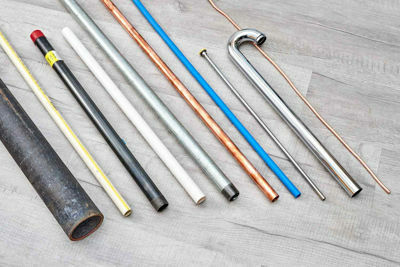
Of all the things that go into building or renovating a house, plumbing is arguably one of the most important. Plumbing is what makes the difference between a comfortable and livable home and a disaster waiting to happen. But what types of pipes should you use to plumb your house? In this blog post, we’ll take a look at the different types of pipes available and their pros and cons.
- PVC Pipes
PVC pipes are a popular choice for residential plumbing because they are lightweight, easy to install, and inexpensive. They come in different sizes and lengths and are resistant to corrosion, making them suitable for use in areas with high levels of moisture. PVC pipes are also highly durable and long-lasting, and they are resistant to chemicals and ultraviolet light. However, they are not suitable for hot water systems, as they can melt or warp at high temperatures. PVC pipes are almost always used for the waste water flowing from drains.
Pros:
- Lightweight and easy to install
- Inexpensive compared to other types of pipes
- Resistant to corrosion, making them suitable for use in areas with high levels of moisture
- Highly durable and long-lasting
- Resistant to chemicals and ultraviolet light
Cons:
- Not suitable for hot water systems as they can melt or warp at high temperatures
- Can become brittle and crack over time
- Not suitable for outdoor use as they can be damaged by ultraviolet ligh
- Copper Pipes
Copper pipes are a traditional choice for plumbing because they are highly durable, resistant to corrosion, and can withstand high temperatures. They are ideal for hot water systems and are often used in residential plumbing. Copper pipes are also highly resistant to bacteria growth, making them a good choice for use in drinking water systems. However, they can be expensive and are prone to theft because of their high scrap value. They are one of the more common pipes used, but is slowly being overtaken by PEX piping.
Pros:
- Highly durable and long-lasting
- Resistant to corrosion and can withstand high temperatures, making them ideal for hot water systems
- Highly resistant to bacteria growth, making them suitable for use in drinking water systems
Cons:
- Expensive compared to other types of pipes
- Prone to theft because of their high scrap value
- Can be difficult to work with
- PEX Pipes
PEX pipes are a newer type of plumbing material that have gained popularity in recent years. They are flexible, easy to install, and less expensive than copper pipes. PEX pipes are also highly durable and resistant to corrosion, making them suitable for use in areas with high levels of moisture. They are also resistant to freezing and bursting in cold weather. However, PEX pipes can be damaged by ultraviolet light and may not be suitable for outdoor use.
Pros:
- Flexible and easy to install
- Less expensive than copper pipes
- Highly durable and resistant to corrosion, making them suitable for use in areas with high levels of moisture
- Resistant to freezing and bursting in cold weather
Cons:
- Can be damaged by ultraviolet light, so may not be suitable for outdoor use
- Not as long-lasting as copper pipes
- Can be difficult to repair if damaged
- Galvanized Steel Pipes
Galvanized steel pipes are another traditional choice for plumbing, but they are not as common as they used to be. They are highly durable and can withstand high temperatures, but they are prone to corrosion and can become clogged over time. They are also difficult to work with and can be expensive. For the most part, galvanised pipes are no longer used in new home develeopments.
Pros:
- Highly durable and can withstand high temperatures
- Can be used for both hot and cold water systems
- Resistant to mechanical damage
Cons:
- Prone to corrosion and can become clogged over time
- Difficult to work with and can be expensive
- Not suitable for drinking water systems because of the risk of lead contamination from the zinc coating
- CPVC Pipes
CPVC pipes are similar to PVC pipes, but they are designed to withstand higher temperatures. They are commonly used in hot water systems and are highly durable and long-lasting. However, they are more expensive than PVC pipes and can be difficult to install.
- Highly durable and long-lasting
- Can withstand higher temperatures than PVC pipes, making them suitable for hot water systems
- Resistant to corrosion and chemicals
Cons:
- More expensive than PVC pipes
- Can be difficult to install because of the need for special glue and fittings
- Not suitable for outdoor use because of the risk of damage from ultraviolet light
There are several different types of pipes available for residential plumbing, each with its pros and cons. The choice of pipes will depend on your specific needs, such as your budget, the location of your home, and the type of water system you have. It's important to choose the right type of pipes to ensure the longevity and safety of your plumbing system.

